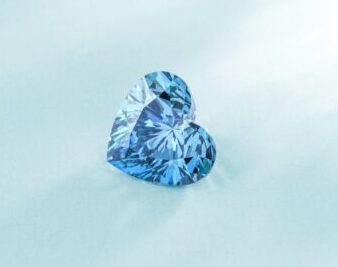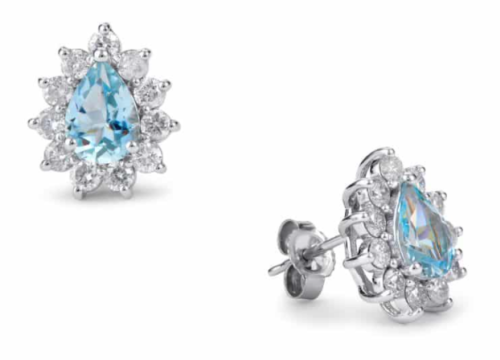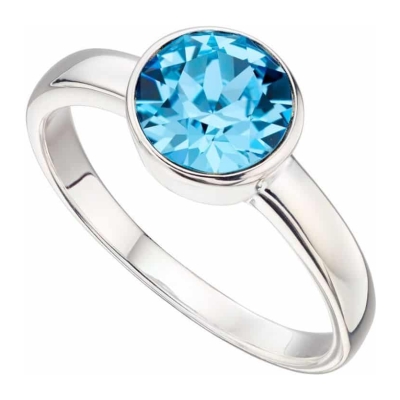All months of the year have their own special birthstone and the March birthstone is no exception. The birthstone for March hints that spring days are just around the corner and that lighter colours are slowly but steadily taking over.
Aquamarine is the most popular birthstone jewellery for anyone born in March and thanks to its stunning light blue colour, similar in appearance to blue topaz, it’s a beautifully refreshing gemstone after the cold days of winter and is a perfect companion for a diamond in an engagement ring as well as any other Aquamarine rings.
So, what is Aquamarine? Where does it come from, and what are its properties? Here, we’ll take a look at what this gemstone actually is, as well as its origins and properties, where it’s used and how much it’s worth.
What Is Aquamarine?

Aquamarine gems are a form of a mineral composed of beryllium aluminium cyclosilicate, often known as Beryl. It’s quite a common gemstone, with only a few varieties that are rare including dark blue stones, often with a greenish blue hue.
The gemstone Aquamarine has a long history, and thanks to its light blue colour & high clarity, it has often been connected to the sea in many cultures. In fact, Aquamarine has been said to be the protective gemstone of sea travellers and is said to keep fishermen safe while they are out on the waters and is reputed to have been able to cure ailments.
The March gemstone Aquamarine grows more popular with consumers year on year, but why is that the case? To find out, let’s dive into this stunning gemstone in more detail.
The Origin of Aquamarine
Although the gem has been known and used since at least 500BC, the name “Aquamarine” only appeared for the first time as late as 1677. As part of the Beryl mineral family, Aquamarine is also linked with gemstones like Emerald, Morganite, and Heliodor, and its formation process is exactly the same as that of Emerald.
Formation Process
Aquamarine forms beneath the Earth’s crust, when magma comes into contact with the minerals beryllium, aluminium, silicon, and sometimes iron. Its official chemical formula, for those who really want to know, is Be3Al2Si6O18.
Once the rock forms, it’s known as pegmatite, and magma continues to heat it up until, depending on which minerals are inside, the aquamarine crystals are formed.
Although Emerald is well-known to have a lot of “inclusions” (which are deviations or fractures from the clear crystal structure), its sister gemstone Aquamarine is very clear and clean, so it falls into the Type 1 clarity category.
Aquamarine Clarity
There are usually 3 grades of clarity (type 1, type 2, and type 3) by which all gemstones (except Diamonds) are graded, and Aquamarine crystals easily fall into the Type 1 category. As you might imagine, the better the clarity, the higher the price. However, just like everything else that’s found in the natural world, Aquamarine can, of course, be found in a wide range of different shapes, sizes and clarities.
Usually, Aquamarine gems are blue (as you might imagine from their name), and that’s how they’re found in nature. But the reason why we say “usually” is because sometimes there can be a hint of slightly greenish blue hues in there too. If you come across an Aquamarine gemstone that has a more greenish hue to it, there’s a good chance that it hasn’t been treated.
Heat Treatment
Gemstones are usually treated with high heat to improve their clarity, and to get rid of any fractions and inclusions that they contain. Some gemstones always have to be treated in this way, whilst others like Aquamarine don’t.
When Aquamarine is heat treated, it’s usually because the manufacturers want to make it an even purer blue shade, simply because pure blue Aquamarine always sells better than the variations that contain a green colour. Heat treatment removes the iron from the composition which eradicates the green hint and leaves Aquamarine its pure natural blue colour.
Aquamarine Strength
When it comes to its strength, on a Mohs scale of hardness, Aquamarine holds a pretty good record of 7.5 to 8. It is found in many locations, with the best-known mines in mountainous regions of Zambia, Tanzania, India, Russia, North and South America.
One final interesting fact about Aquamarine, is that it often comes in very large sizes. Naturally occurring pieces can even weigh over 100lbs!

Aquamarine Jewellery And Its Meaning
Aquamarine crystal gems are most often used to make jewellery. Unlike some other gemstones, it isn’t used for any industrial purposes. Beautiful pieces such as earrings, bracelets, necklaces, and even the odd engagement ring can be found with Aquamarine gemstones, and their popularity grows every year — check out some of these beautiful pieces in our online store!
Besides jewellery, just like with any other gemstone, Aquamarine ranks highly in alternative medicine and it’s believed it brings health & healing properties.
It’s said that Aquamarine can help with building confidence and can improve the overall health of the respiratory system. Also, many people believe that Aquamarine is the protector of sea travellers and that it brings luck to fishermen.
Either way, with or without these properties, the Aquamarine birthstone evokes positive feelings thanks to its incredible beauty.
How Much is Aquamarine Worth?
Aquamarine usually costs around £500 per carat but due to its size, carat growth usually increases the price by 40-60%. So, a single carat Aquamarine can cost around £500, but 2-3 carats would cost around £750-1100.
There are also lab-grown Aquamarines, and they cost far less, as they are not as rare as natural ones, and there’s no mining process involved.
The Bloodstone Birthstone – The Other Birthstone for March
The bloodstone, or heliotrope, is a dark red to green/black gemstone composed of trace amounts of iron oxide and quartz. It is one of two March birthstones. For centuries, it has been said to have magical powers due to its rich red colour and unique markings.
Religious Beliefs
Drops of Jesus’ blood were said to have fallen onto a green jasper stone during his crucifixion, creating the bloodstone. As a result, it has long been regarded as a symbol of bravery and strength, particularly during times of adversity or injustice. The red spots in the stone were said to represent Christ’s mercy, and they were thought to protect whoever wore or held it from harm. This legend lives on in some cultures today, with people believing that carrying the stone with them will bring them good luck and protection from harm.
The bloodstone birthstone is associated with both religious beliefs and medicinal properties. The red-spotted stone was used for healing by the Ancient Egyptians, who applied it to wounds or took it internally to treat various ailments. Heliotropes are frequently used in Ayurvedic medicine to treat inflammation and joint pain.
Bloodstone Origins
Despite its ancient origins, modern society appreciates the beauty and symbolism of this red-black gemstone, which is why it is still used as a birthstone alongside more traditional stones such as diamond or sapphire. Its distinct pattern distinguishes each stone and makes it desirable, while also serving as a powerful reminder that we must remain courageous even in our darkest hours.
Wearing bloodstone jewellery, in addition to being an enduring symbol of courage and protection, can make an individual feel extra special because these gems are so rare; no two pieces are alike! Furthermore, because red is often associated with passion and energy in modern culture (especially now that red has become such a popular colour choice), anyone who chooses to wear heliotrope jewellery will look stylish while exuding confidence!
There’s no denying that the bloodstone has something for everyone, from its mystical origins in Christianity to its healing properties in Ayurvedic medicine and its modern appeal as an eye-catching birthstone choice.
Whether you choose this gem because you are facing adversity or simply because you appreciate its aesthetics, you will not be disappointed in your choice of this one-of-a-kind red-black gem for your wardrobe!
Aquamarine March Birthstone Jewellery
Silver jewellery has always been an excellent choice of birthday gift for someone born in March, and when silver is paired with a gorgeous birthday gemstone it becomes an even more special and personal choice, especially for a special item like an engagement ring.
Aquamarine is a beautiful gemstone and is the March birthstone. It’s a very popular gem, and its popularity is continually growing thanks to its stunning colour and ability to fit into any type of jewellery.
Are you interested in seeing some of the most amazing Aquamarine jewellery pieces in our range? Then check out our shop here! We have a stunning selection of other birthstone jewellery pieces too that make perfect gifts for someone special in your life.

